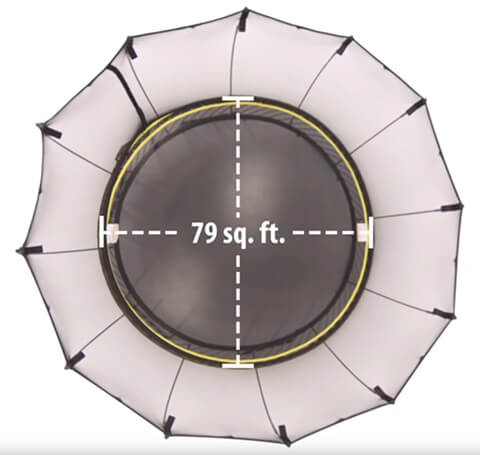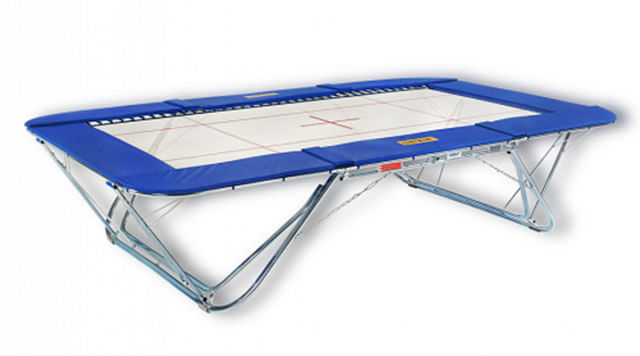In the old days when backyard trampolines began to be somewhat popular, people were convinced that only gymnasts and cheerleaders are capable enough to use them. But the truth is everything but this as more and more people of every age tend to use it regularly.
Kids have a fantastic time jumping on it, playing games, and working out simultaneously, not even realizing it. The benefits it’ll bring for their overall health are enormous.
Choosing a trampoline size that fits best can be a hard task. It is in human nature that people want to buy the biggest one available on the market. But is this really necessary? Well, not exactly as this is in most cases completely unnecessary.
Do I need any previous gymnastics experience?
No, everybody can jump on the trampoline as no previous experience is needed. Only make sure that you jump within your skillset. Don’t expect that doing flips is easy and that you should immediately try it. For a start, just some regular bouncing should be enough. You do not have to be a gymnast to use a trampoline, and there are several health benefits associated with trampolines that should convince you!
Is there minimum age limit?
Generally, there is the age limit for standard outdoor trampolines where age 6+ is considered as a bare minimum for using trampolines bigger than 10 ft.
For younger children, we would recommend ones designed specifically for them. Bear in mind that kids trampolines are usually smaller in size and can be used indoors, all year long. But, if you do purchase a bigger one it’ll be just fine, but don’t expect that bounce provided shall be high as supposed to (laws of physics, as small children aren’t applying enough weight/force onto springs).
What is the best size for a trampoline?
One of the most common questions as people are generally not sure how all that sizing works, so the first question is always “Is a 12ft trampoline, as this is average trampoline size, big enough for my child?” or “Is there any notable difference between 14 and a 15-foot trampoline?“, and there really is no straight-forward answer, as what may be fine for one it may not suit another.
Consider the following:
- Who shall be using it?
As you might presume, there is no point buying a 14ft or bigger trampoline if only the bouncer will be a toddler or small child. In that case, it is best to buy 8 ft or 10 ft trampoline.
12 ft trampolines can be purchased if they will be used by older children, 8 years old and above, and 14 ft / 15 ft only for teenagers or if planning to have multiple children playing games.
Always try to match children’s age and capabilities with the size of the trampoline. Also, the next aspect of the decision is the size of your garden. Take those facts into consideration and you’ll get a perfect size, one that will suit your needs! - Will it fit your backyard?
We always want the best & biggest, but there were cases when people forgot that their backyard is not big enough for trampoline ordered… Most likely this can occasionally happen when people order online, without seeing how big that trampoline really is.
- Who shall be using it?
- Weight limit (how much weight can a trampoline hold)
Weight limit is important mostly on smaller trampolines, up to 8ft, as others are tested for 220+ lbs, with a maximum up to 800 lbs on ACON rectangle trampoline. Have in mind that 220 lbs are a mostly conservative weight limit set by manufacturers and that most of the trampolines can handle much more (let’s say 260 lbs as a minimum).
How Much Weight Can A Trampoline Hold? – Weight Limits
Figuring how and being able to understand how much weight a specific trampoline can hold is a crucial thing to ensure everyone is safe. The good news is finding this information out shouldn’t be too difficult. The weight it can hold is typically going to be available and provided by the manufacturer. With that being said, being able to trust the weight is correct is a different story altogether.
The amount of weight that a trampoline can hold is going to ultimately impact the overall price that you pay for the product. For this reason, brands typically display higher weight limits on their products to make them much more appealing in the marketplace. For this reason, it is important to look at the weight limits skeptically. In this article, we will be going over some of the best ways to ensure that you are getting a trampoline that is going to be able to hold the intended weight you need and want.
Do all trampolines have the same weight limit?
No. The trampoline weight limit is different on all of them, based on several elements from which trampoline is made of. Starting from different designs, all the way to frame thickness, springs, mat quality – every single part has a huge impact on the maximum weight limit of the bouncer.
Some general specifications for weight limitations are based on trampoline size and shape:
SIZE:
Typically, the smaller the model, the lower the overall weight limit. Therefore, if you are interested in purchasing a small trampoline for your kid, it is pretty safe to assume that it is not going to be able to hold the weight of an adult. Generally, those trampolines are going to max out at around 150 pounds. At the same time, the larger backyard trampolines (weight limits below) can handle around 400+ pounds. Thus, it should be enough to handle safely around 2 to 3 adults, even though we never encourage more than one person at a time.
SHAPE:
The actual shape of the trampoline that you are looking at and purchasing is going to play a critical role in determining the overall weight limit as well. Typically, a rectangular shape is going to be much more likely to be able to hold more weight than its round counterpart. This is because rectangular models are generally designed in a specific way that ultimately reduces the amount of stress that is placed on the springs at any given time. Whereas, a round trampoline will utilize the strength of the springs during each and every bounce regardless of the actual location that you are bouncing. The location is going to determine the springs that are being used for rectangular trampolines, and therefore, not all springs will be getting used at the same time.
Not to mention, professional gymnasts use rectangular trampolines, so the companies are generally incentivized to increase the weight limits for them because they understand the amount of stress that they are going to be put through as a result of the usage that they are going to be put through.
Weight limits of ROUND trampolines:
- 8ft trampolines – max 175 lbs
- 10ft trampolines – from 150 – 250 lbs
- 12ft trampolines – from 200 – 300 lbs
- 14ft – 16ft trampolines – from 250 – 400 lbs
Weight limits of RECTANGULAR trampolines:
- All trampoline sizes – from 250 – 800 lbs
Weight limits of OVAL trampolines:
- 16ft trampolines – from 300 – 450 lbs
Weight limits of OCTAGONAL trampolines:
- from 250 lbs+
MATERIALS USED
The materials that are utilized in the production are another thing that can greatly impact the overall weight limits as well. The most important aspects are the springs, frame, and jumping pad. If any one of these materials/aspects is not high quality, your trampoline is going to suffer from a lower weight limit. For this reason, it is critical to find a model that is made by a reputable manufacturer within the industry.
We encourage you to compare trampolines
How to calculate the overall jump area out of diameter?
First, take into consideration the fact that some trampolines do have padding, so measure this as well and subtract from the previous results before going to multiply.
- Round Trampolines
The formula for the area of a circle is the radius squared multiplied by the constant pi, or 3.14159.- Measure the diameter of the circular area in feet using the tape measure. The diameter is a straight line that passes through the center of a circle.
- For example, assume the diameter of the trampoline to be 15 ft. Now let’s subtract width of trampoline pad for 1ft (15ft-1ft=14ft).
- Divide the length of the diameter by 2 to find the radius (14 / 2 = 7). The radius is 7 ft.
- Multiply the radius by itself to square the number (7 x 7 = 49). Multiply the result by pi (3.14159), so (49 x 3.14159 = 153.9).
- The result is the area of the circle in square feet–153.9 square feet.

- Rectangle Trampolines
Easy. Just measure the length and width of each side and then multiply those two numbers together to get the jumping area in feet squared (ft2).
For more information read our trampoline buying guide!
How much do trampolines weigh?
What are the available shapes of trampoline and when to use which?
They do come in several shapes, and each one has its purpose. They are available in five main types: round, rectangular, oval, square (which were introduced only to fill out a gap between round and rectangular as they take the best qualities of both), plus some additional shapes, like octagonal.
There is one more category that covers more and more popular mini trampolines. Click here for reviews of best mini trampolines.
Is there really any difference when jumping on different shapes of trampolines?
This answer is pretty straightforward – YES, and if you really want the best bouncing experience then only rectangular, oval, and springless can be considered.
The difference between them is that rectangular is better in height of bounce, but they are not so safe as trampolines can be, not even close to springless but pretty similar to round ones. Which to buy is all about why you need it, recreational or training purposes.
- If part-time recreation is the main reason, the round trampoline would be my first choice.
- If the main reason is training, rectangular shape is what you need as round mostly do not have enough jumping area for performing tricks (but are safer because jumpers in round trampolines are always directed to the center of trampoline jumping surface and rectangular will give you best performance and available space (but are less safer because jumpers alone decide where it’ll land on a mat).
- With ovals, you can get enough room for tricks and as the design is similar to round ones, they also point bouncers back to the center of the trampoline mat. It’s a kinda win-win situation, where oval’s picked up best of both worlds.
More info:
I want the best available trampoline on the market for recreational purposes. Which should I buy?
If you plan to use your trampoline for recreational purposes on a daily basis consider buying a 14 or 15 ft round trampoline, Olympic-sized 10x17ft or a bit smaller 9 x 15 ft rectangular trampoline, 8 x 13 ft large oval spring-based or springless trampoline. Of course, when it comes to trampolines big as those, the size of the backyard matters. Always try to leave as 3ft of empty space from each side.
Which is the safest trampoline?
All trampolines that we review on our site meet all the recommended safety guidelines. Truly dangerous ones are rare, and you won’t find them here – only in brick and mortar stores as low-cost units. Generally, Springless trampolines are being considered as safest in the world, but they do come with a nice price tag.
Of course, it would be unfair to say that some of them simply aren’t safer than others as they have a tighter enclosure, thicker padding, tighter enclosure net, etc.
Vuly Thunder is your nuclear option for safety, but it’s also mighty expensive, truly a premium unit for those who demand absolute perfection, and the same could be told for JumpSport Elite or Skybound Stratos. It all depends on what you really need!
If you want the safest trampolines for your kids, there are plenty of dedicated small kids trampolines whose frame is not so high as on regular ones. A perfect example is Skywalker 8ft Jump N’ Dunk, whose frame is just 21 inches tall (1,75 feet).
If you’re aiming for indoor ones, for toddlers or smaller children, then you’ll get ones with legs made of sturdy plastic and springs that provide a gradual bounce to aid the kids in keeping their balance.
How long do they last?
The durability of a trampoline mostly depends on the brand. Upscale brands use higher-grade materials that can better resist the wind, rain, and other natural elements. There are no two ways about it – luxury brands definitely last longer than bargain products.
However, with regular maintenance, cleaning, and careful use, even an average one can last well over 7 years with original parts. Take care that not all parts are equally likely to fail. Frames will certainly outlast everything else.
Trampoline pads are often the first to fail. The plastic can fray and look ugly, but if you’re unlucky it can tear away completely. Then come the mats, enclosure netting, and last, the springs. The more layers of stitching the mat have, the longer lasts.
Plenty of them have reasonably priced spare parts, so if say your mat breaks, you can grab a new one for $100 instead of getting a new trampoline.
Professional Trampolines Vs. Outdoor Recreational Trampolines
Professional trampolines are intended to be more powerful and more durable compared to normal trampolines. Generally, the elasticity of these trampolines is situated all throughout the springs as they require more rigidity and firmness. Professional trampolines come only in one shape – as rectangular trampolines!
What is the difference between home and pro trampolines:
• Professional trampolines, in spite of their size, are easy to move from one place to the other.
• They are usually used by professionals/semi-pro’s for additional training, and in some situations, by aspired individuals who may use it for exercise.
• Their fabrics are specially developed and made sturdier than regular backyard trampolines but are still considerably lightweight allowing easy transport.
• The average base size of this type of trampoline is 14 – 17 feet.
• All these features, especially the springs, which are considerably longer on pro-products, are what allow them to bounce much higher.
Trampolines for professional use are expected to cost more than normal backyard ones and this price is reasonable – features top quality that a lot of professional athletes rely on, especially in cases where this is used for business or in competition.
Ultimate 4×4, made by Eurotramp, is a true competition-grade trampoline used in the Olympics and World Trampolining Championship!

There are a lot of advantages of having a trampoline of this type. It’s a good practice to research thoroughly first on the particular type you need by looking up some more information on the internet or probably you could find someone who has familiarity and knowledge about them. From there, you can decide which is best. You need to consider all angles like the quality, the safety, the price, etc.
How NOT to get hurt!?
This is an interesting question but unfortunately, there is no unique answer. But we can tell you this:
- always read the trampoline user manual as it’ll help you get started with training, if nothing more, you’ll learn some basic moves to start with!
- always use trampoline safety pads and trampoline enclosure – they are a lifesaver,
- check mat for cuts or tearing before every jumping session,
- check if springs are firmly attached to frames and mat,
- DO NOT over-estimate your abilities. Learn to bounce properly before performing any tricks,
- DO NOT let children inside the trampoline without supervision. Trampoline is not a kindergarten,
- If neighbor’s kids come over to play any trampoline games, talk to them about the rules!

